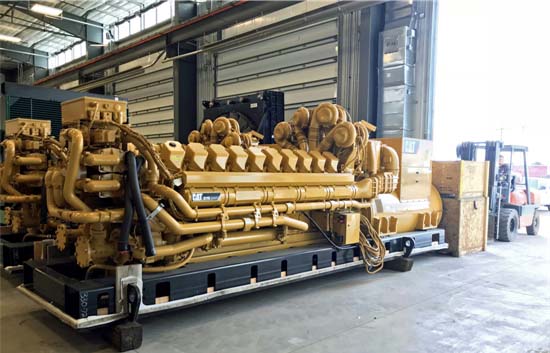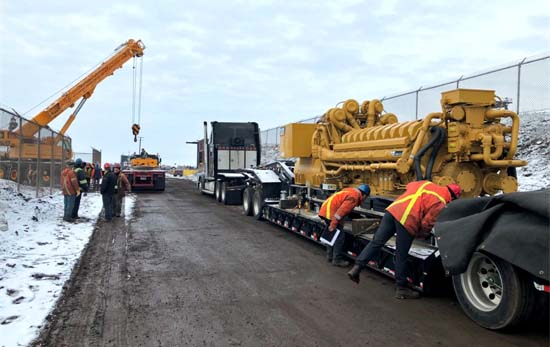4000 kW Caterpillar Generator Ships to Steel Mill
Steel mill selects 4000 kW Caterpillar Generator for backup power, see the details here!

A Canadian steel mill recently experienced a power outage that lasted for two days and caused the mill to shut down. The downtime occurred when their installed backup generators did not successfully start, it was very costly and unpleasant. The mill's engineers realized the urgent need for a medium voltage backup diesel generator to keep the mill running during future power outages. The mill found Generator Source online and in a matter of a few weeks, we had one of the world's largest high-speed generators in route to their facility north of the border. Read more about how we helped fulfill the requirements in the details below:
Steel Mill Experiences Power Outage Lasting for Days
Loss of utility power at a Canadian steel mill caused the following chain of events:
- The installed emergency generators did not fire or startup, and could not be used during the outage.
- The power outage lasted for two days, and the mill had to shut down.
- The downtime was costly, and their staff calculated the size of the generator needed. The mill is operated at 2400 Delta Voltage @ 1200 amps.
- The client's engineering team determined a 4000 kW generator, with a 4160 VAC output wired in a Delta configuration would allow the mill to continue operation during power outages.
The client found us through an online search and spoke with our representative about their generator requirements. In addition, we helped them confirm their engineering calculations were correct. The day the purchase was complete, we shipped the generator from our facility in Brighton. The entire process took about three weeks to complete.
A Caterpillar C175-20 diesel engine is the prime mover for the Caterpillar SR5 generator. The engine is controlled by the ADEM A4 Engine Control Module (ECM) supported by a common rail fuel system design. The generator controller is an EMCP 4 controller.

The EMCP 4 controller is an advanced generator Human Machine Interface (HMI) panel that controls the overall generator functions. It communicates with the ECM to maintain engine speed through varying electrical grid load demands. The operator can perform multiple tasks from the panel. The installation of this generator will save the client lost dollars when the utility power fails.
Loading, LIfting and Delivering the Generator North of the Border
The generator weighs 51,588 pounds with a length of almost 22 ft and a width of over 7-1/2 feet. Our pre-approved shipper arrived with two tractor-trailers capable of carrying over-sized loads. The generator and radiator were loaded with the yard crane and fork truck. The shipping company then secured the load for transport.
This load was destined to cross multiple state lines. Each state has an individual Department of Transportation (DOT). Permits must be purchased for each state the load passes through. Once the trucks arrive at the border, they must have a Canadian Carrier Code, Cargo Control Document, Commercial Invoice, and a Pre-Arrival Review System to name a few. After crossing the border, a permit for each provenience entered or crossed must be obtained. Crane service was arranged for the arrival of the generator. It is important the crane is ready to complete the unloading process when the trucks arrive. Open lines of communication between the customer, trucker, crane supplier, and seller ensured a smooth evolution.

We have been in the generator business for over 35 years. We can provide generators and can arrange for shipping to a worldwide audience. Our inventory of in-stock new and pre-owned generators can usually ship within 24-hours of purchase. Often, we arrange crane services at the customer destination. Aiding in permits acquisition and border requirements are part of our customer service package.
Contact Us for more information or with any critical power generator questions.
Medium Voltage Use in Steel Mills
While we are not sure what the mill will do with the medium voltages used in these applications, we do know that steel mills can use the voltages to power:
- Smelting Furnaces - Electric arc and induction
- Rolling Machine - Large motors work more efficiently with voltages such as 4160 VAC
- Transformers - Step-Up transformers to power higher voltage units. Step-down transformers for low voltage equipment
Smelting Furnaces
In the early days of steel production, fossil fuel powered blast furnaces were used to bring the metal or ore to the molten state. Advancements in technology now allow steel mills to use an electric arc or induction furnace.
Electric arc furnaces can range from 1-ton units for cast iron products to the 400-ton units used in large steel mills. When electrodes are lowered to the ore or recycled steel, a high-voltage arc is produced. This arc melts the material. Arc furnaces have a higher operating temperature, less dissolved gases, quick startup, longer life refractory lining, and can produce a variety of steels.
Electric induction furnace uses electric currents to produce molten metal. The furnace works on two principles:
- Electromagnetic Induction - Furnace contains a coil wrapped around pot. When current flows through coil an electromagnetic fie
 ld is formed (sometimes called eddy currents). The current flow leads to joule heating
ld is formed (sometimes called eddy currents). The current flow leads to joule heating
- Joule Heating - Often referred to as ohmic or resistive heating. As the current flows through the coil heat is developed to turn metal molten.
Understanding Rolling Mills
A rolling mill is a piece of equipment that reduces the thickness of a metal ingot in various steps of compression. The machine applies large amounts of pressure to the ingot while passing through the roller system. As the ingot is moved through the machine it is lengthened and widened.
This is considered a cold process because the metal is not in molten form. However, heat is produced and often engineers test temperature of the ingot to ensure it does not rise above specified temperature during the rolling.
Multiple roller machines take the reduced ingot and process it to desired thickness and wind it into a coil. We often see semi-trucks with one or two coils transiting to the next destination. Without backup power machines, controllers and controlling software can suffer issues during startup because of an improper shutdown. Product damage can occur depending on its stage in the rolling phase.
The induction furnace is a rapid, clean non-polluting method of heating. But it cannot process steel and refining is not as extensive as electric arc furnaces.
Both arc flash and induction furnaces require a medium voltage input and can use step-up transformers to satisfy power requirements. Other equipment such as lighting, overhead cranes and low-voltage electric motors receive voltage from step-down transformers. Power loss during the smelting process can cause extensive damage to equipment, resulting in expensive repairs. An emergency generator and associated systems can provide the needed power when utility power fails.
Generator Source has a long history of helping companies across the US and Canada buy, sell, rent and service industrial generators. To see our current invenoty of
generaotrs for sale click here. If you have a question about your next power generation project, give us a call at
800-853-2073 or
contact us online today!
Diesel Blog Team
| 4/16/2019 10:32:26 AM
|
0 comments